Scientists have studied the impacts of a warmer, stronger East Australian Current on marine life during a voyage along the east coast.
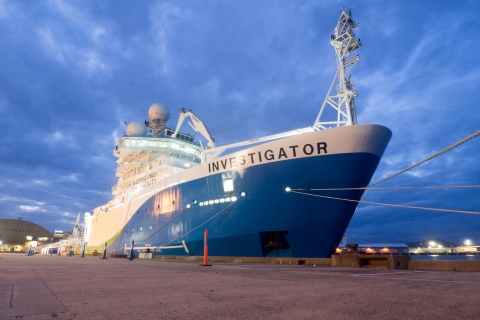
The CSIRO's ocean research vessel, the RV Investigator on the eve of departure from Hobart
Photo: Maurice Huguenin
The CSIRO's ocean research vessel, the RV Investigator on the eve of departure from Hobart
Photo: Maurice Huguenin
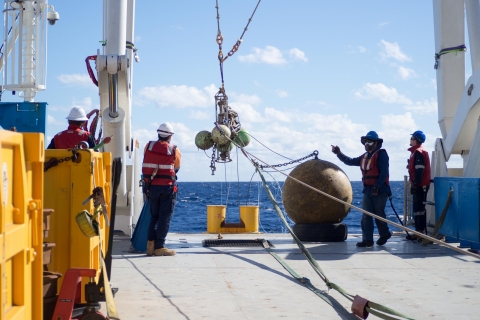
Retrieval of an oceanographic mooring. Photo: Maurice Huguenin
Retrieval of an oceanographic mooring. Photo: Maurice Huguenin
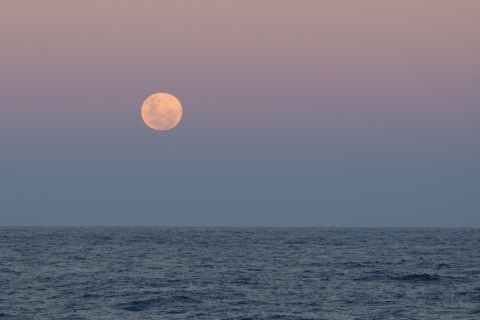
Moonrise over the EAC, prior to the lunar eclipse. Photo: Maurice Huguenin.
Moonrise over the EAC, prior to the lunar eclipse. Photo: Maurice Huguenin.
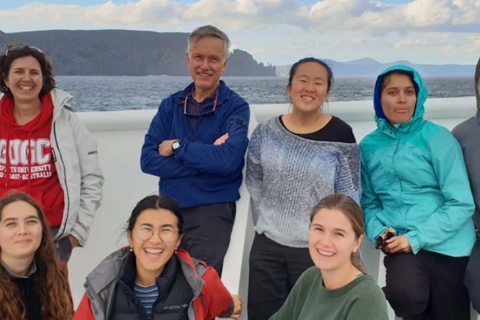
Group photo of biologists from UNSW and Griffith University (GU) (Left to Right: Pauline Lindholm (GU), Prof. Kylie Pitt (GU); Jade Arnold (GU); Prof Iain Suthers (UNSW); Clare Cao (UNSW); Megan Suthers (UNSW); Carolina Olguin Jacobson (GU). Photo: Chris Chapman CSIRO
Group photo of biologists from UNSW and Griffith University (GU) (Left to Right: Pauline Lindholm (GU), Prof. Kylie Pitt (GU); Jade Arnold (GU); Prof Iain Suthers (UNSW); Clare Cao (UNSW); Megan Suthers (UNSW); Carolina Olguin Jacobson (GU). Photo: Chris Chapman CSIRO

Larval fish sample of a metamorphosing lantern fish. Photo: Jade Arnold.
Larval fish sample of a metamorphosing lantern fish. Photo: Jade Arnold.
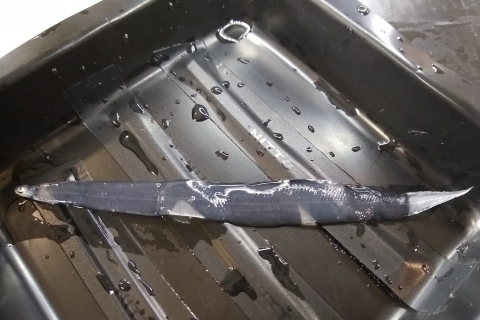
Larval fish sample of a larval eel. Photo: Megan Suthers.
Larval fish sample of a larval eel. Photo: Megan Suthers.
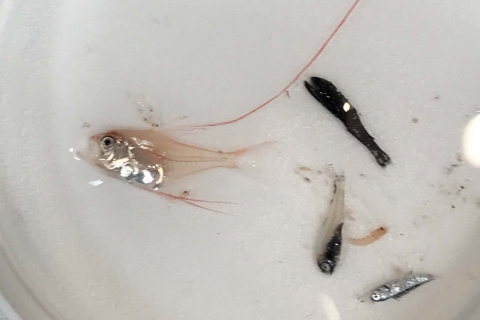
Larval fish sample of a post-larval Beryx (a deep water alfonsino), along with juvenile lanternfish and goatfish. Photo: Iain Suthers.
Larval fish sample of a post-larval Beryx (a deep water alfonsino), along with juvenile lanternfish and goatfish. Photo: Iain Suthers.
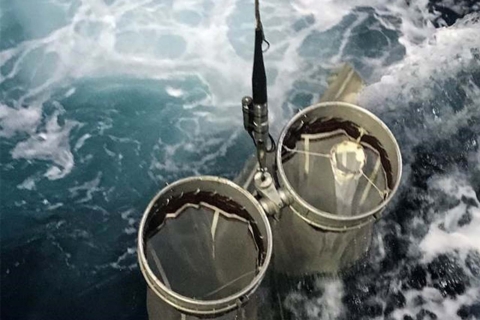
Bongo/plankton nets used to take fish samples. Credit: Iain Suthers.
Bongo/plankton nets used to take fish samples. Credit: Iain Suthers.

Photomicroscope view of zooplankton, including a salp (Salpa fusiformis). Photo: Kylie Pitt
Photomicroscope view of zooplankton, including a salp (Salpa fusiformis). Photo: Kylie Pitt
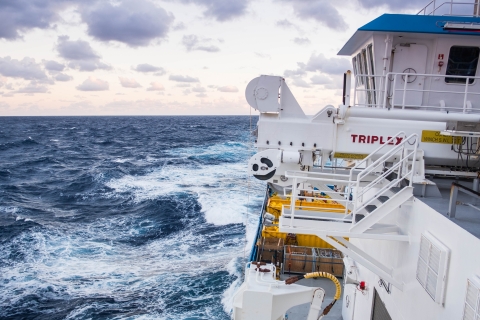
View out to sea from the RV Investigator. Photo: Pauline Lindholm.
View out to sea from the RV Investigator. Photo: Pauline Lindholm.
Several UNSW scientists have returned from a four-week voyage along Australia's eastern coastline gathering data on the changing East Australian Current [EAC] and observing its effect on fish reproduction.
While oceanographers from UNSW helped the crew on board CSIRO Research Vessel (RV) Investigator to recover and redeploy deep ocean moorings off North Stradbroke Island and Brisbane, UNSW biologists sampled for larval fishes along the eastern seaboard, between Hobart and Brisbane.
UNSW Science's Professor Iain Suthers, a biological oceanographer based at the Sydney Institute of Marine Science, said the moorings are part of the national ocean monitoring program, the Integrated Marine Observing System.
The mooring depths range from 500 metres to five kilometres deep, measure the temperature and salinity of the EAC over nine years, and need to be serviced by CSIRO every 18 months.
"This research is critical to evidence of long-term trend at key locations, to understand which new fish species are coming down the coast because of changes in the East Australia Current that flows from the Coral Sea south towards Tasmania," Prof. Suthers said.
"We know that climate change is causing the EAC system to warm significantly more than other regions, and as a consequence, it is bringing the larvae of tropical reef fish into our temperate rocky reefs off Sydney, Eden and even Hobart.
"Some of these tropical species eat kelp, removing important habitat and productivity."
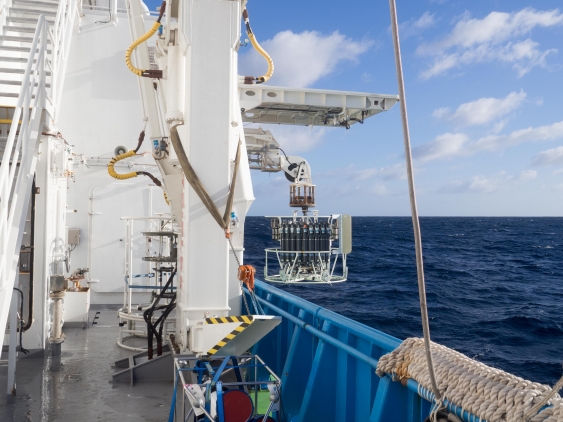
Oceanographers from UNSW helped with the operation and sampling of the Conductivity, Temperature and Depth instrument (pictured) which recorded vertical profiles of water mass properties. Photo: Maurice Huguenin.
The oceanography team included UNSW Science's Dr Amandine Schaeffer and Dr Michael Hemming from the School of Maths, and a PhD candidate in the Climate Change Research Centre, Maurice Huguenin.
"CSIRO scientists are now analysing the 18 months of data we collected from the deep ocean moorings, which will be invaluable to understand the trends in the EAC, including below the surface where most of the transport occurs," Dr Schaeffer said.
"We also chased eddies (rotating bodies of warm ocean water), trying to find and characterise the evolution of a frontal eddy, which was travelling southward at the edge of the EAC between Fraser Island and Brisbane.
"We believe that these 20 to 50km patches of rotating water are critical for the interaction and transport of water from different origin (from the shore, the tropics or deep water), creating a very distinct habitat for marine life."
While the moorings were recovered during the day, the biology team from UNSW worked at night sampling larval fish caught in plankton nets such as goatfish, snapper, anchovy and eels.
"We were examining the biology and oceanography that drives the fish communities to become more tropical ecosystems, otherwise known as 'tropicalisation'," Prof. Suthers said.
"From each net we sorted hundreds and sometimes thousands of larval fish along with the small zooplankton and jellyfish which affect the survival of these larval fish."

Photomicroscope view of zooplankton, including a salp (Salpa fusiformis). Photo: Kylie Pitt.
He said the 2-10 mm long larval fish are in embryo and juvenile form and are translucent or even iridescent when alive.
"They live in plankton but are beautiful representations of adults, although the taxonomy is not yet well understood," he said.
"We took photographs and a sample of their tissue for their DNA to indicate their species and morphology, to prepare for future identification technologies such as artificial intelligence."
The scientists will compare the new samples with ones caught during previous RV Investigator voyages and data from the Integrated Marine Observing System, which has been operating since 2006.
Prof. Suthers said scientists already know the EAC is transporting larval fish into new territories.
"For example, the pink snapper in Eastern Victoria come from New South Wales," he said.
"Victoria is also getting yellowtail kingfish for three out of 12 months, but in 10 to 20 years of ocean warming, Victoria will see these fish for up to six months a year.
"The tropical mahi mahi fish will soon be a regular Victorian and Tasmanian fish; while a sea urchin found off New South Wales now occurs in Tasmania and has consumed and removed the kelp which provided habitat for abalone and lobster."
During the RV Investigator voyage, honours student Clare Cao and post-doctoral researcher Paloma Matis from UNSW's School of Biological, Earth and Environmental Sciences found a variety of different larval tuna, some of which have not been described off eastern Australia.
The larval fish samples also assisted an ongoing study by UNSW PhD student Charlie Hinchliffe from the School of Biological, Earth and Environmental Sciences, who compared the growth and mortality of larval sardine with the previous mooring voyage in September 2019.
"The ratio of growth and mortality determines the overall survival of sardines, which helps to forecast sardine numbers in one to two years time," Prof. Suthers said.
"We are closing in on the 100-year-old question about why fishery yields fluctuate from year to year.
"It's a fundamental challenge of fisheries science."
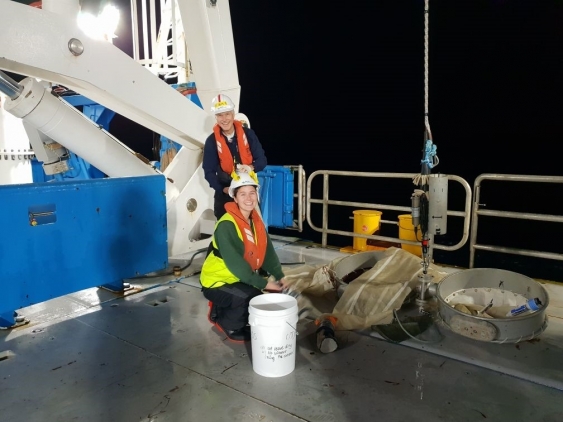
Iain Suthers and Megan Suthers (UNSW) collecting zooplankton from a plankton net. Photo: Supplied.
Prof. Suthers said it was both surprising and concerning to see an abundance of plastic fibre in the plankton tow samples off Maria Island and Brisbane.
"We haven't seen as much plastic fibres before as we did on this trip," he said.
"We estimate that plastic shreds were on average about five for every 10 cubic meters of water that we sampled.
"It would be interesting to go back to our stored samples from the 1980s to document the trend, and with this baseline we could then determine how successful our efforts are to rid the ocean of plastic in the future."
Ms Cao, Mr Hinchcliffe and Dr Matis will publish their findings on the data collected on this voyage by the end of this year.
Prof. Suthers said the findings will be instrumental during his Fulbright Scholarship at fisheries and science centres in California next year.
All the data collected on the voyage will be used to advise fisheries management agencies on what changes in fish stocks they can expect and how they will need to adapt to climate change.
This research was supported by a grant of sea time on RV Investigator from the CSIRO Marine National Facility.
















